parking brake CADILLAC CATERA 1997 1.G Owners Manual
[x] Cancel search | Manufacturer: CADILLAC, Model Year: 1997, Model line: CATERA, Model: CADILLAC CATERA 1997 1.GPages: 338, PDF Size: 18.02 MB
Page 62 of 338

Downloaded from www.Manualslib.com manuals search engine ,== -a .
Section 2 Features and Controls
Here you can learn about the many standard and optional features on your Catera, and information on starting,
shifting and braking. Also explained are the instrument panel and the warning systems that tell you
if everything is
working properly
-- and what to do if you have a problem.
2-2
2-
3
2-6
2- 10
2-1 1 2-12
2-
13
2- 14
2-15
2-16
2-
17
2-19
2-24 2-25
2-27
Keys
Door Locks
Remote Keyless Entry System (RKE)
Trunk
Theft
Theft-Deterrent (System)
Immobilizer
New Vehicle “Break-In”
Ignition Positions Starting Your Engine
.Engine Coolant Heater
Automatic Transmission Operation
Parking Brake
Shifting Into PARK
(P)
Shifting Out of PARK (P) 2-28
2-29
2-29
2-30
2-32
2-32
2-39
2-46
2-48
2-50
2-5
1
2-52
2-55
2-5 8
2-6
1
Parking Over Things That Burn
Engine Exhaust
Running Your Engine While You’re Parked
Windows Tilt Wheel
Turn Signal/Multifunction Lever
Lamps Mirrors
Storage Compartments
Ashtrays and Cigarette Lighter
Cellular Telephone
Sunroof
Universal Transmitter
Instrument Panel
Warning Lights, Gages and Indicators
Page 80 of 338
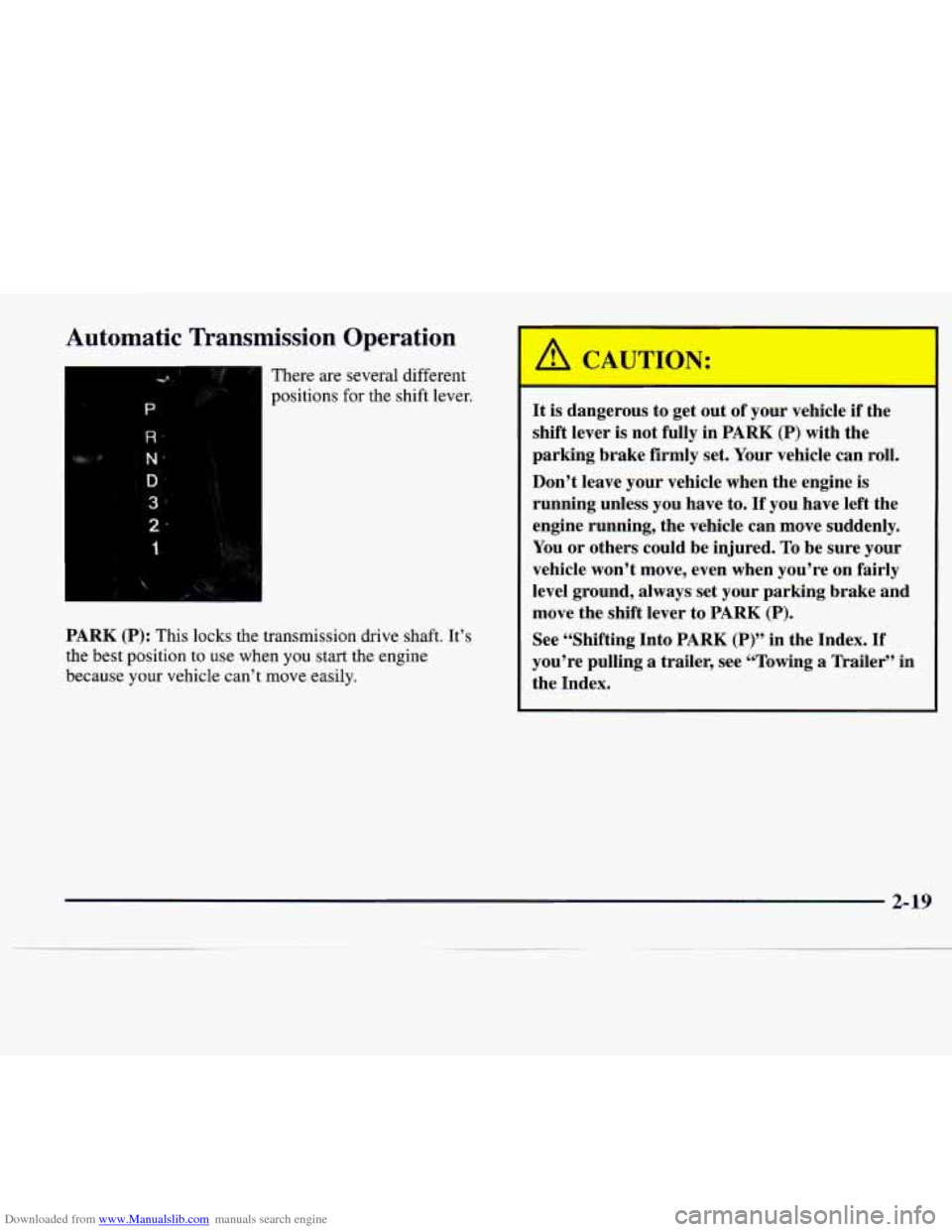
Downloaded from www.Manualslib.com manuals search engine Automatic Transmission Operation
There are several different
positions for
the shift lever.
2-
PARK (P): This locks the transmission drive shaft. It’s
the best position to use when you start the engine
because your vehicle can’t move easily.
A CAUTION:
I
It is dangerous to get out of your vehicle if the
shift lever
is not fully in PARK (P) with the
parking brake firmly set. Your vehicle can roll.
Don’t leave your vehicle when the engine
is
running unless you have to. If you have left the
engine running, the vehicle can move suddenly.
You or others could be injured. To be sure your
vehicle won’t move, even when you’re on fairly
level ground, always set your parking brake and
move the shift lever to
PARK (P).
See “Shifting Into PARK (P)” in the Index. If
you’re pulling a trailer, see “Towing a Trailer” in
the Index.
2-19
Page 85 of 338
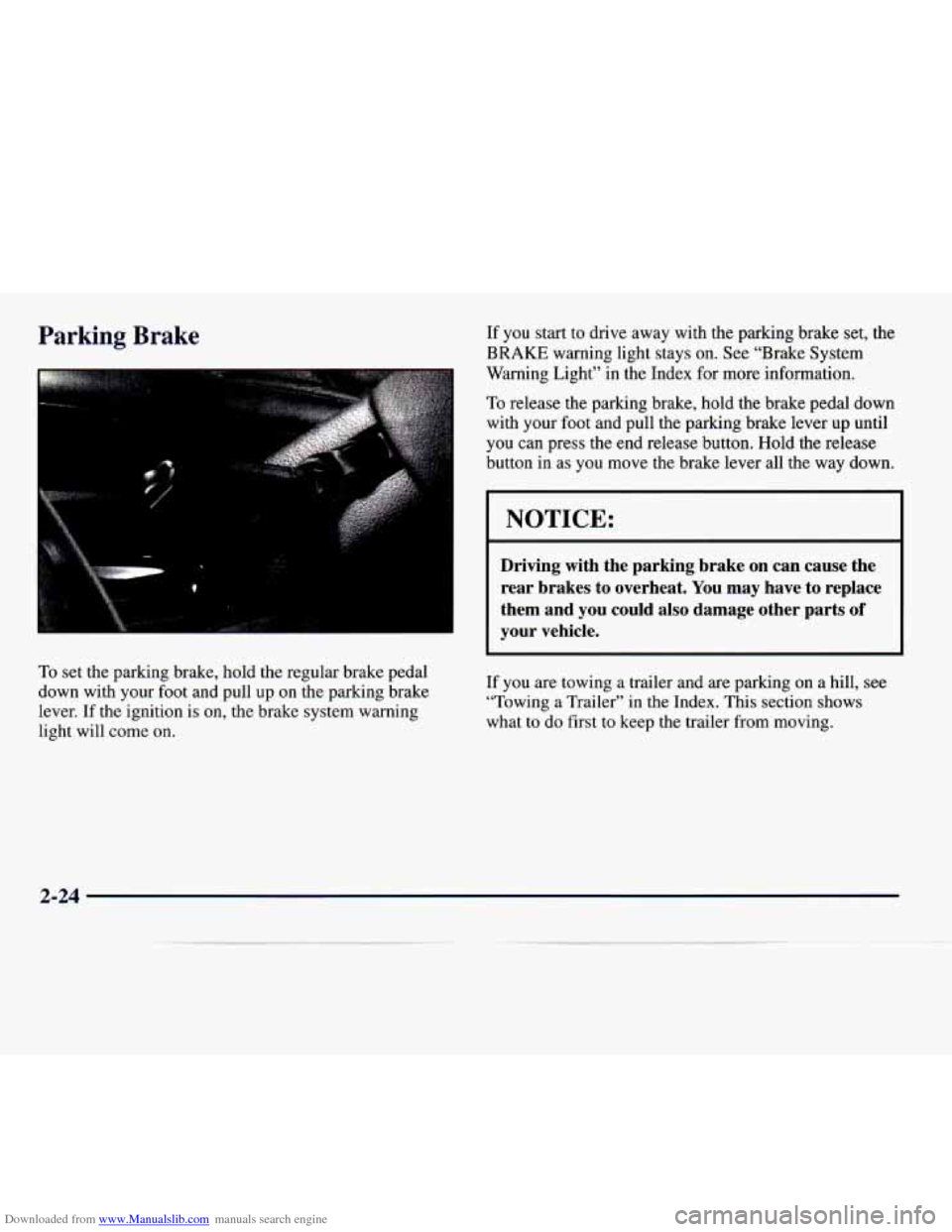
Downloaded from www.Manualslib.com manuals search engine Parking Brake If you start to drive away with the parking brake set, the
BRAKE warning light stays on. See "Brake System
Warning Light" in the Index for more information.
To release the parking brake, hold the brake pedal down
with your foot and pull the parking brake lever up until
you
can press the end release button. Hold the release
button in as
you move the brake lever all the way down.
1 .. .
0
NOTICE:
Driving with the parking brake on can cause the
rear brakes to overheat. You may have to replace
them and you could also damage other parts
of
your vehicle.
To set the parking brake, hold the regular brake pedal
down with your foot and pull
up on the parking brake
lever.
If the ignition is on, the brake system warning
light will come on. If you
are towing a trailer and
are parking on a hill, see
"Towing a Trailer" in the Index. This section shows
what to do first to keep the trailer from moving.
2-24
Page 86 of 338
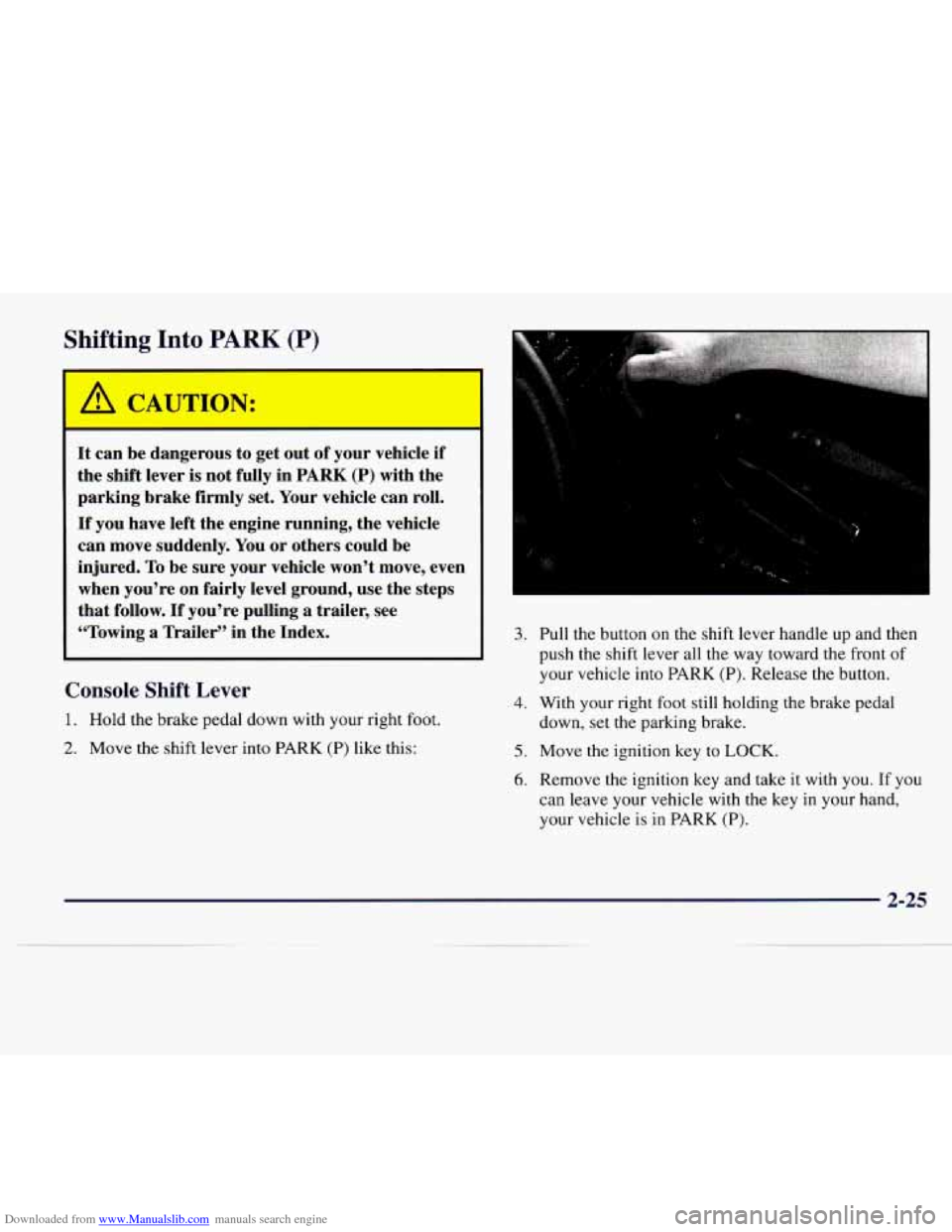
Downloaded from www.Manualslib.com manuals search engine Shifting Into PARK (P)
It can be dangerous to get out of your vehicle if
the shift lever is not fully in
PARK (P) with the
parking brake firmly set. Your vehicle can roll.
If you have left the engine running, the vehicle
can move suddenly. You or others could be
injured.
To be sure your vehicle won’t move, even
when you’re on fairly level ground, use the steps
that follow.
If you’re pulling a trailer, see
“Towing
a Trailer” in the Index.
Console Shift Lever
1. Hold the brake pedal down with your right foot.
2. Move the shift lever into PARK (P) like this:
..
3. Pull the button on the shift lever handle up and then
push the shift lever all the way toward the front of
your vehicle into PARK
(P). Release the button.
4. With your right foot still holding the brake pedal
down, set the parking brake.
5. Move the ignition key to LOCK.
6. Remove the ignition key and take it with you. If you
can leave your vehicle with the key in your hand,
your vehicle is
in PARK (P).
2-25
Page 87 of 338
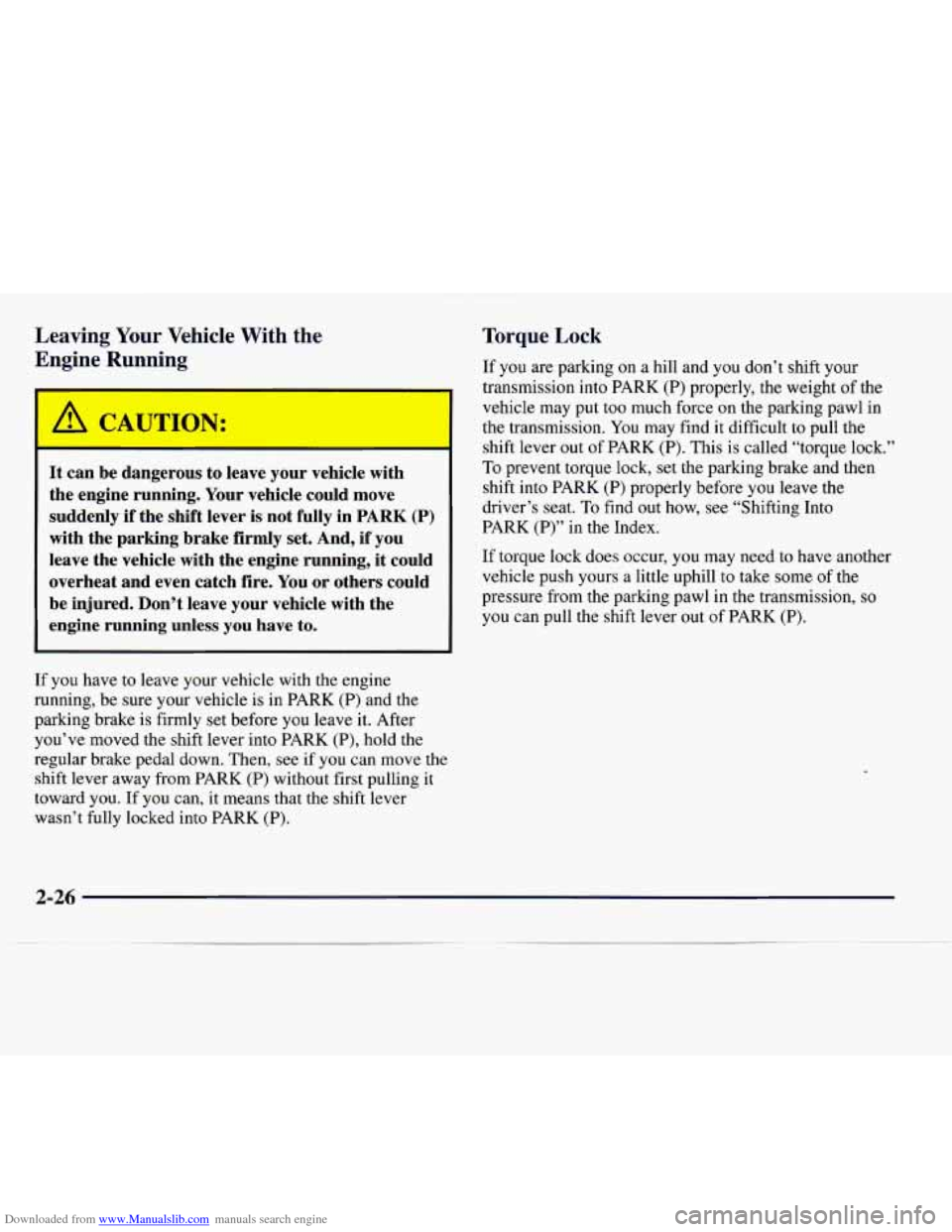
Downloaded from www.Manualslib.com manuals search engine Leaving Your Vehicle With the
Engine Running
It can be dangerous to leave your vehicle with
the engine running. Your vehicle could move
suddenly if the shift lever is not fully in
PARK (P)
with the parking brake firmly set. And, if you
leave the vehicle with the engine running, it could
overheat and even catch fire. You or others could
be injured. Don’t leave your vehicle with the
engine
running unless you have to.
L
Torque Lock
If you are parking on a hill and you don’t shift your
transmission into PARK (P) properly, the weight
of the
vehicle may put too much force on the parking pawl
in
the transmission. You may find it difficult to pull the
shift lever out of PARK
(P). This is called “torque lock.”
To prevent torque lock, set the parking brake and then
shift into PARK
(P) properly before you leave the
driver’s seat.
To find out how, see “Shifting Into
PARK
(P)” in the Index.
If torque lock does occur, you may need to have another
vehicle push yours
a little uphill to take some of the
pressure from the parking pawl in the transmission,
so
you can pull the shift lever out of PARK (P).
If you have to leave your vehicle with the engine
running, be sure your vehicle is in PARK (P) and the
parking brake is firmly set before you leave it. After
you’ve moved the shift lever into PARK
(P), hold the
regular brake pedal down. Then, see if you can move the
shift lever away from PARK
(P) without first pulling it
toward you. If you can, it means that the shift lever
wasn’t fully locked into PARK (P).
2-26
Page 91 of 338
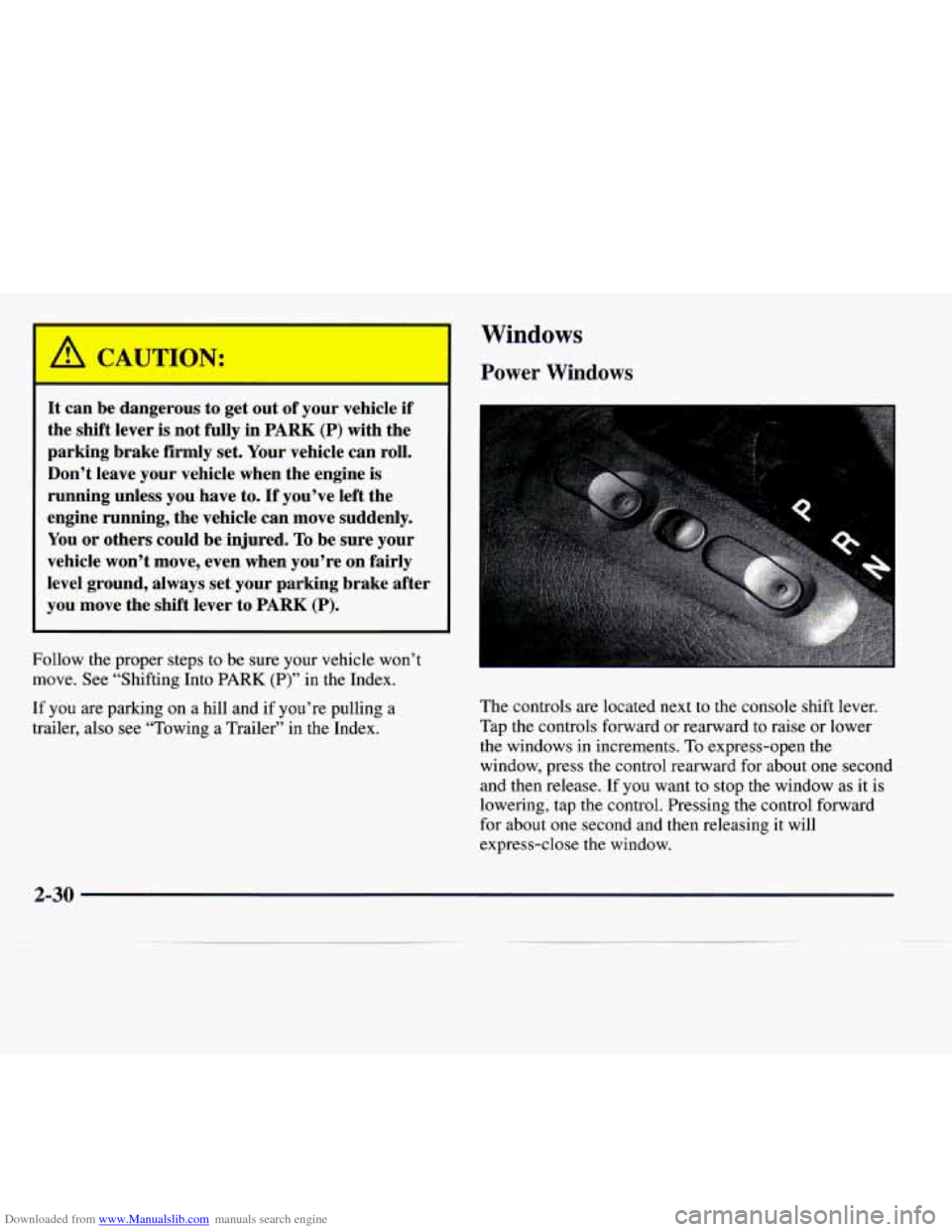
Downloaded from www.Manualslib.com manuals search engine It can be dangerous to get out of your vehicle if
the shift lever
is not fully in PARK (P) with the
parking brake firmly set. Your vehicle can roll.
Don’t leave your vehicle when the engine
is
running unless you have to. If you’ve left the
engine running, the vehicle can move suddenly.
You or others could be injured.
To be sure your
vehicle won’t move, even when you’re on fairly
level ground, always set your parking brake after
you move the shift lever to PARK
(P).
Follow the proper steps to be sure your vehicle won’t
move. See “Shifting Into PARK
(P)” in the Index.
If you are parking on a hill and if you’re pulling a
trailer, also
see “Towing a Trailer’’ in the Index.
Windows
Power Windows
The controls are located next to the console shift lever.
Tap the controls forward or rearward to raise or lower
the windows
in increments. To express-open the
window, press the control rearward for about one second
and then release. If you want
to stop the window as it is
lowering, tap
the control. Pressing the control forward
for about one second and then releasing it will
express-close the window.
2-30
Page 125 of 338
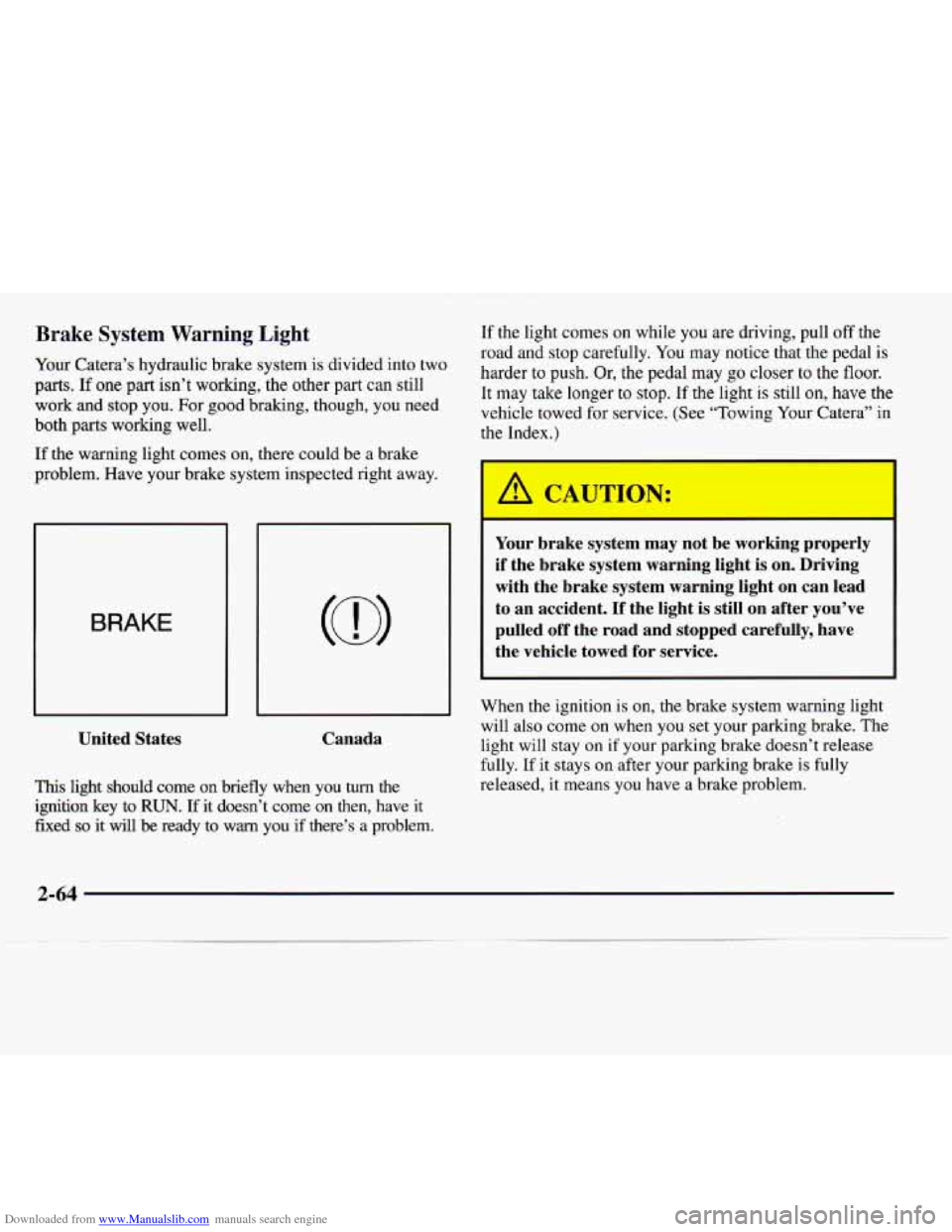
Downloaded from www.Manualslib.com manuals search engine Brake System Warning Light
Your Catera’s hydraulic brake system is divided into two
parts. If one part isn’t working, the other part can still
work and stop you. For good braking, though,
you need
both
parts working well.
If the warning light comes on, there could be a brake
problem. Have your brake system inspected right away.
BRAKE
United States Canada
This light should come on briefly when you turn the
ignition key to
RUN. If it doesn’t come on then, have it
fixed so it will be ready to warn you if there’s a problem. If
the light comes
on while you are driving, pull off the
road and stop carefully.
You may notice that the pedal is
harder
to push. Or, the pedal may go closer to the floor.
It may take longer to stop. If the light is still on, have the
vehicle towed for service. (See “Towing Your Catera” in
the Index.)
I
/d CAZ
Your brake system may not be working properly
if the brake system warning light is on. Driving
with the brake system warning light on can lead
to an accident. If the light is still on after you’ve
pulled off the road and stopped carefully, have
the vehicle towed for service.
When the ignition is on, the brake system warning light
will also come on when
you set your parking brake. The
light will stay on
if your parking brake doesn’t release
fully. If
it stays on after your parking brake is fully
released, it means you have a brake problem.
2-64
Page 134 of 338
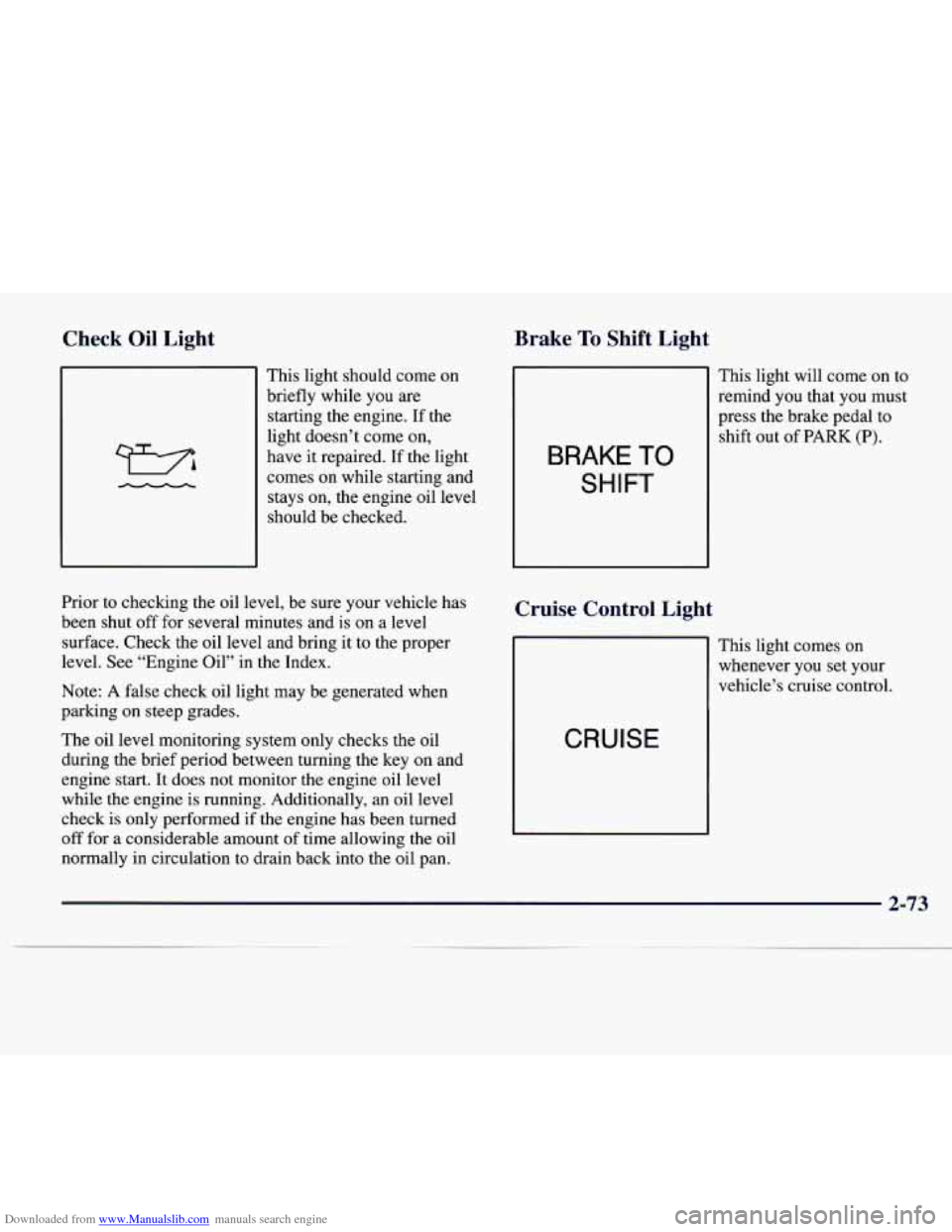
Downloaded from www.Manualslib.com manuals search engine Check Oil Light Brake To Shift Light
This light shoula come on
briefly while you are
starting the engine. If the
light doesn’t come on,
have it repaired.
If the light
comes
on while starting and
stays on, the engine oil level
should be checked.
Prior to checking the oil level, be sure your vehicle has
been shut off for several minutes and
is on a level
surface. Check the oil level and bring it to the proper
level. See “Engine Oil” in the Index.
Note:
A false check oil light may be generated when
parking
on steep grades.
The oil level monitoring system only checks the oil
during the brief period between turning the key on and
engine start. It does not monitor the engine oil level
while the engine is running. Additionally,
an oil level
check is only performed
if the engine has been turned
off for a considerable amount of time allowing the oil
normally
in circulation to drain back into the oil pan. This
light will come on to
remind
you that you must
press the brake pedal to
shift out
of PARK (P).
BRAKE TO
SHIFT
I
Cruise Control Light
This light comes on
whenever you set your
vehicle’s cruise control.
CRUISE
2-73
Page 177 of 338
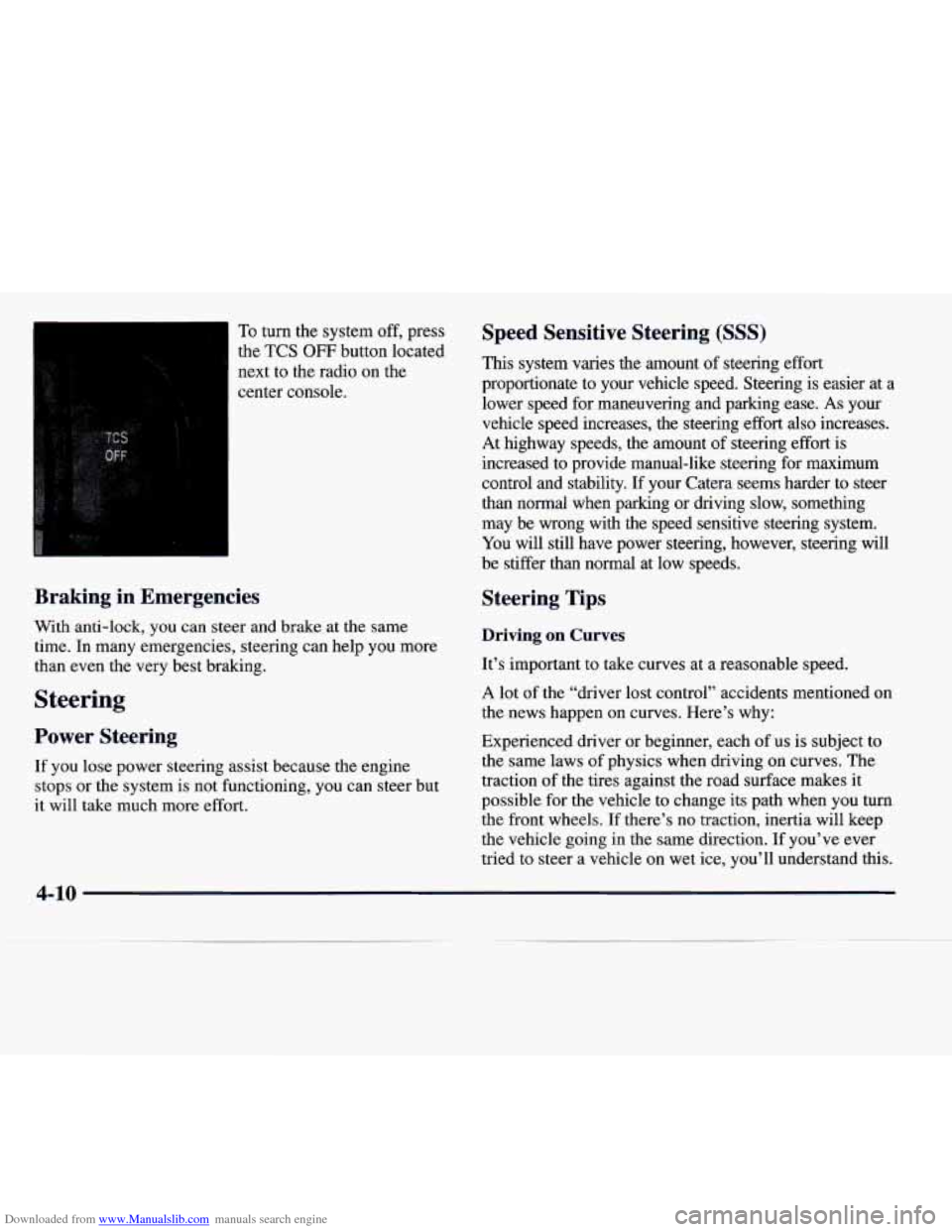
Downloaded from www.Manualslib.com manuals search engine To turn the system off, press
the
TCS OFF button located
next to the radio on the
center console.
b
Braking in Emergencies
With anti-lock, you can steer and brake at the same
time. In many emergencies, steering can help
you more
than even the very best braking.
Steering
Power Steering
If you lose power steering assist because the engine
stops or the system is not functioning, you
can steer but
it will take much more effort.
Speed Sensitive Steering (SSS)
This system varies the amount of steering effort
proportionate to your vehicle speed. Steering is
easier at a
lower speed for maneuvering and parking ease. As your
vehicle speed increases, the steering
effort also increases.
At highway speeds, the amount of steering
effort is
increased to provide manual-like steering for maximum
control and stability.
If your Catera seems harder to steer
than normal when parking or driving slow, something
may be wrong with the speed sensitive steering
system.
You will still have power steering, however, steering will
be stiffer than normal at low speeds.
Steering Tips
Driving on Curves
It’s important to take curves at a reasonable speed.
A lot of the “driver lost control” accidents mentioned on
the news happen on curves. Here’s why:
Experienced driver or beginner, each
of us is subject to
the same laws of physics when driving on curves. The
traction
of the tires against the road surface makes it
possible for the vehicle to change its path when you turn
the front wheels.
If there’s no traction, inertia will keep
the vehicle going in the same direction.
If you’ve ever
tried to steer a vehicle on wet ice, you’ll understand this.
4-10
Page 205 of 338

Downloaded from www.Manualslib.com manuals search engine Parking on Hills
You really should not park your vehicle, with a trailer
attached,
on a hill. If something goes wrong, your rig
could start to move. People can be injured, and both
your vehicle and the trailer can be damaged.
But if
you ever have to park your rig on a hill, here’s
how to do it:
1. Apply the regular brakes, but do not shift into
PARK
(P).
2. Have someone place chocks under the trailer wheels.
3. When the wheel chocks are in place, release the
regular brakes until the chocks absorb the load.
4. Reapply the regular brakes. Then shift into
5. Release the regular brakes. PARK (P) firmly and apply the parking brake.
When You Are Ready to Leave After
Parking on a Hill
1. Apply your regular brakes and hold the pedal down
while you:
Start your engine;
Shift into a gear; and
2. Let up on the brake pedal.
3. Drive slowly until the trailer is clear of the chocks.
4. Stop and have someone pick up and store the chocks.
Maintenance When Trailer Towing
Your vehicle will need service more often when you’re
pulling a trailer. See the Maintenance Schedule for more
on this. Things that are especially important
in trailer
operation are automatic transmission fluid (don’t
overfill), engine oil, axle lubricant, belt, cooling system
and brake adjustment. Each
of these is covered in this
manual, and the Index will help you find them quickly.
If you’re trailering, it’s a good idea to review these
sections before
you start your trip.
Check periodically to see that all hitch nuts and bolts
are tight.
4-38